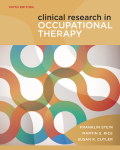
Clinical research in occupational therapy
Rice, Martin
Stein, Franklin
Cutler, Susan
Thoroughly updated, the 5th edition of CLINICAL RESEARCH IN OCCUPATIONAL THERAPY enables the graduate student and clinical researcher to design and carry out a research study from the formulation of a research hypothesis to collecting data utilizing user friendly step-by-step procedures. An introductory chapter on the history of medical research aquaints the student with the relationship between research and clinical practice. Step-by-step procedures and examplesare used throughout to guide the student through the process of selecting a topic, reviewing literature, designing research protocols, selecting outcome measures, implementing research, and writing the results. Descriptive and inferential statistics are explained in a step-by-step procedure, and examples of qualitative and quantitative research are included so as to provide the student with tools to conduct their own research and evaluate current research data. Asection on writing questionnaires and surveys helps students construct reliable and valid instruments, and information on scientific writing and thesis preparation is presented. Additionally, ethical considerations for informed consent are addressed, with examples of consent forms included. INDICE: 1. A SHORT HISTORY OF THE SCIENTIFIC METHOD IN MEDICINE, REHABILITATION, AND HABILITATION..Definition and Purposes of Research in Occupational Therapy and Special Education. Historical Review of Research in Medicine, Rehabilitation, and Habilitation. Biological Description, Stage I. Methodological Process, Stage II. Etiological Advances, Stage III. Prevention, Stage IV. Chemotherapy, Surgery, and Hospital Care: The Bases of Treatment, Stage V. Rehabilitation Movement, Stage VI. Habilitation and Special Education, Stage VII. Research and the Future of Health Care..2. THE SCIENTIFIC METHOD AND RESEARCH MODELS. .Science, Research, and Theory. Fallacies Related to Research. Critical Analysis of the Research Process. Qualities of a Researcher. Nomothetic Versus Idiographic Methods. Types of Inquiry. Models of Research..3. QUANTITATIVE RESEARCH MODELS..Factors in Quantitative Research Models. Experimental Research. Methodological Research. Evaluation Research. Heuristic Research. CorrelationalResearch. Survey Research. Summary..4. QUALITATIVE RESEARCH MODELS..Defining Qualitative Research. Characteristics of Qualitative Research. Types of Qualitative Research. Collecting Qualitative Data. Analyzing Qualitative Data. Credibility in Qualitative Research..5. THE RESEARCH PROBLEM..The Need for Problem-Oriented Research in the Health Professions. Selecting a Significant Research Problem. Identifying Problems Resulting From a Disability. Identifying Significant Issues in Professional Education. Justifying the Research Problem. Narrowing the Investigation. Psychological Blocks in Selection of a Research Problem. Worksheet Guide for Selecting a Research Problem. Why Research Proposals AreDisapproved..6. REVIEW OF THE LITERATURE..The Need for a Literature Review. Conceptual View of a Literature Search. Locating Sources of Related Literature.Recording Information from Research Articles. Evaluating Validity of ResearchFindings. Outlining the Literature Review Section. Worksheet for Literature Review..7. RESEARCH DESIGN AND METHODOLOGY..Proposing a Feasible Research Question. Statement of Hypothesis. Operationally Defining a Variable. Stating Assumptions. Diagrammatical Relationship between Variables. Theoretical Rationale. Internal Validity. Methods Section. Selection of Participants. Size of Sample.Selection of Measuring Instrument. Ethical Principles Guiding Human Research.Data Collection Procedures. Methodological Limitations of a Study..8. DATA ANALYSIS AND STATISTICS..Definition and Meaning of Statistics. Relationship of Statistics to Clinical Practice. Key Definitions of Statistical Concepts. SevenStatistical Models for Clinical Research. Model I: Descriptive Statistics: Organization and Tabulation of Descriptive Data. Inferential Statistics and Testing a Hypothesis. Model II: One-Sample Problems (One-Sample t Test). Model III: Two Independent Groups. Model IV: Paired Data Sample. Model V: k-IndependentSamples. Model VI: Correlation (Pearson and Spearman Correlation Coefficients). Model VII: Observed Frequencies (Chi-Square). Statistical Software Packages. Summary..9 SELECTING A TEST INSTRUMENT..Key Concepts in Testing. Early History of Test Development. Outline of Overall Evaluative Process of Testing. Characteristics of a Good Test in Clinical Research. Assumptions in Clinical Evaluation. Major Purposes of Testing in Clinical Research. Conceptual Model for Selecting a Test Instrument for Clinical Research. Bibliographic Sources. Test Instruments. Reviewing and Evaluating Tests. Criterion-References Tests and Normative-Referenced Tests. Test Publishers. Ethical Considerations in Testing. Conclusion..10. SCIENTIFIC WRITING AND THESIS PREPARATION..Preparation for Writing. Outlining the Research Study. Writing the First Draft. Making Revisions. Quotations, Referenced Material, and Bibliographic Citations. Format of a Paper. Sample Proposal of a Graduate Research Project. Preparation for Presentation. .Conclusion..Appendix A-l Web Addresses of Selected Professional Associations..Appendix A-2 Selected List of Consumer Health Organizations..Appendix A-3 Commonly Used Medical Abbreviations..Appendix B Landmarks in the History of Occupational Therapy..Appendix C Statistical Tables.Glossary..References..Index.
- ISBN: 978-1-111-64331-7
- Editorial: South Western
- Encuadernacion: Rústica
- Páginas: 624
- Fecha Publicación: 20/02/2012
- Nº Volúmenes: 1
- Idioma: Inglés
